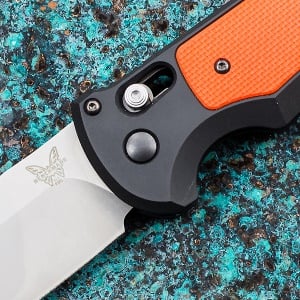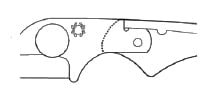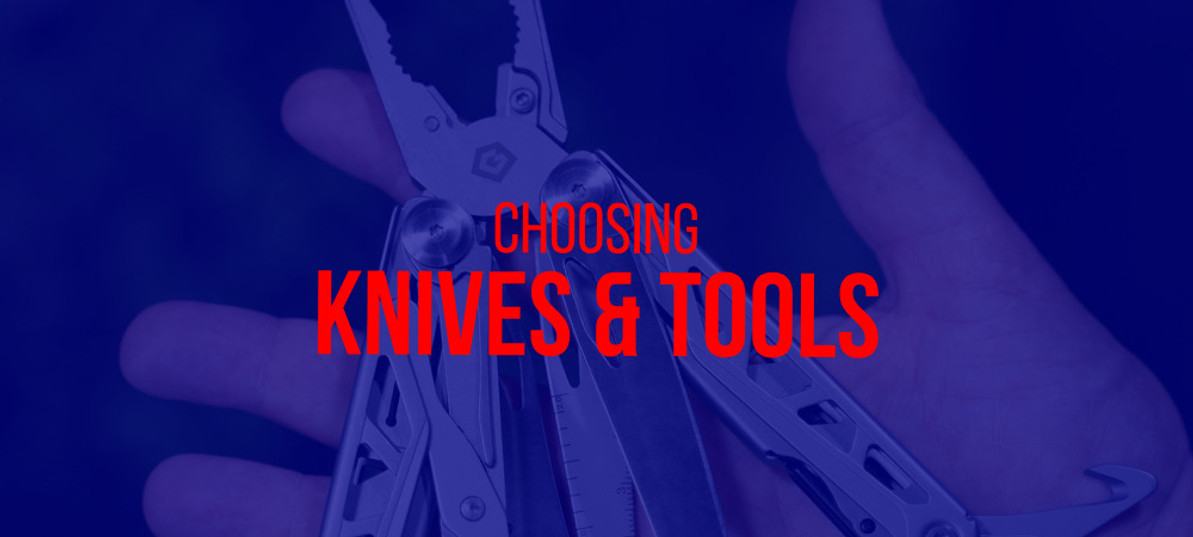Choosing the Right Knives and Tools for Different Tasks
Having a multi-tool or a knife when you're outdoors is essential for safety and convenience. A multi-tool can help you with various tasks, from cutting branches and opening cans to adjusting something on your gear and performing other repair work. A camping/hunting knife is also helpful for preparing food and defending against wild animals, while a small tactical knife can become a great EDC. To successfully deal with all these tasks, your tool or knife needs to be enduring and reliable, so how do you choose one?
We'll guide you through different aspects of multi-tools and knives so you can choose the best one for your needs.
What Knife Type Do You Need: Fixed Blade vs. Folding Blade
All knives can be classified into fixed blade and folding blade types, each having its benefits and drawbacks.
Folding-Blade Knives
Most pocket knives are folding type and have blades that fold into the handle for portability. They are typically lightweight, compact, and ergonomic, making them great for everyday carry and light camping tasks. However, they aren't as sturdy as fixed-blade knives and can prove unreliable in tougher circumstances.
Fixed-Blade Knives: Half-Tang vs. Full-Tang
Fixed-blade knives, on the other hand, feature a single solid piece of metal forming both the blade and handle, making them more durable than folding knives. Because they don’t have a joint that makes a weakness, these are ideal for heavier tasks such as cutting wood or field-dressing game due to their superior strength and stability. Fixed blades can also be more reliable when used in survival situations.
Fixed-blade knives are also classified into half-tang and full-tang knives. A tang is a section of metal that connects the blade of a knife to its handle. So, half-tang knives have a tang that runs only halfway up the handle, making them lighter and less expensive than their full-tang counterparts. However, they are less strong and durable than full-tang knives, which have a tang that extends through the entire length of the handle. On the other hand, full-tang knives can be more expensive and heavier to carry.
What Knife Is Right for You
Choose a fixed-blade knife for:
- Field dressing and other hunting tasks
- Survival scenarios and packing a bug-out bag
- Heavy tactical applications
- Woodcarving
Choose a folding-blade knife for:
- EDC
- Light camping and backpacking tasks
Now, if a folding type is what you want, you need to know about different knife locks because each differs in terms of reliability, ease of use, and deployment time.
Different Types of Folding Pocket Knives Locks
Depending on the application and user preferences, you may need to choose one type over another. Here's a look at seven types of locks with their benefits and drawbacks:
Back Lock

The back lock is one of the oldest mechanisms employed in folding knives. This design utilizes a spine on a spring and works by pressing down on a spine lever that secures the blade in both closed and open positions.
Pros:
- Reliable locking action
- Ease of use
- Budget-friendly
Cons:
- Slow operation since you should press down on the lever with your thumb each time you close or open your knife.
Liner Lock
The liner lock is one of the most popular modern-day designs for folding knives. The working principle is simple: as the blade pivots, a locking liner slides into place to secure the blade in an open position. To disengage, you press the spring bar down to clear contact from the blade.
Pros:
- Ease of use
- Fast operation
Cons:
- Potential wear can reduce tolerance over time, making it less positive in its locking action.
Frame Lock
Unlike liner locks, which are locked open by a separate metal bar, frame locks press the blade into the handle (frame). Because the system puts a more massive piece of metal against the blade, it’s more reliable than liner locks.
Pros:
- Secure locking without excess wear
Cons:
- More expensive than liner lock knives
Axis Lock

Developed by Benchmade Knives, this type utilizes two omega-style spring-loaded bars embedded in the handle. When moved forward, the bar engages with a ramped tang, creating friction and keeping the blade firmly locked in position.
Pros:
- User-friendly ambidextrous opening
- Strength retention despite not having bulky materials inside the handle itself
Cons:
- Potentially complicated repair process
Slipjoint

Slipjoint knives employ a very simple design that, however, requires both hands to open and close the blade. To open the blade, you should overcome the pressure from the spring. When opened, this spring acts as an opposing force.
Pros:
- Low cost
- Simple to maintain and use
Cons:
- Slow deployment
Compression Lock
The Spyderco Compression Lock is a unique knife-locking mechanism that utilizes a leaf spring. When opened, this spring slides into place behind the tang of the knife blade and locks it there, preventing it from closing back while in use.
Pros:
- Minimal operation effort and pressure
- Easy to disengage
Cons:
- Relative complexity compared to other lock types
- Extra wear on moving parts
What Blade Shape is Right For You
Everyone knows the right knife is essential for a successful outdoor or kitchen adventure. But do you know different styles of knife blades serve unique purposes? Here's a quick rundown most common blade shapes and their uses:
Drop-Point Blade: These general-purpose blades are great for controlled slicing, making them a popular choice for hunting knives.
Sheepsfoot Blade: This type of blade has no point but offers a straight edge perfect for tasks like trimming, whittling, and cutting. With this blade, you’re also unlikely to pierce yourself.
Wharncliffe Blade: It has a straight edge that tapers to meet the cutting edge, making it useful for both precise cutting and rough carving.
Straight-Back Blade: This all-purpose blade is best used for chopping and batoning because its spine does not have an angled point like other blades. Besides, its large surface area makes it easy to handle when applying force.
Tanto Blade: This blade type is designed with a reinforced tip to make it stronger than other blades. It’s ideal for stabbing and puncturing thick materials, but this design reduces its versatility in terms of slicing.
Gut Hook Blade: An innovative enhancement on traditional fixed blades, this type of knife features a curved hook having only one task - aid in field-dressing animals.Hawkbill Blade: Though they look intimidating at first glance, they are quite handy when dealing with fibrous materials such as сordage and cloth. It’s also effective for pruning vegetation.
Needle-Point Blade: As the name implies, this symmetrical blade features an incredibly sharp needle-shaped tip and has both edges sharp, making it effective when doing detailed work such as engraving, carving, or piercing thin materials like leather.
Spear-Point Blade: Similar to needle-pointed knives due to having their points in line with the center, these blades may have either one or two sharp edges.
Trailing-Point Blades: Popular among hunters due to their slim profile and lightweight construction, this blade type has its spine curved upwards, which creates an oversized belly for slicing, filleting, and skinning.
Spey-Point Blade: This blade is usually a part of a multi-tool or a combo knife. It’s designed with a pointed tip slightly curved to one side, which creates a short belly and a broad tip useful for tasks where you need to avoid accidental piercing.
Knife Blade Materials
Different materials offer different levels of corrosion resistance, edge retention, and ease of sharpening, so choosing the right one for you will depend on your needs and preferences. Generally, the harder the steel, the better rust resistance and edge retention but with that, the more difficult it is to sharpen.
420HC is an affordable stainless steel alloy with good edge retention and toughness. It’s fairly easy to sharpen but can be prone to rust if not maintained properly.
154CM has improved wear resistance and rust prevention compared to other steels. It also holds an edge well but can be costly compared to other steels.
S30V is a premium stainless steel choice offering excellent edge retention and corrosion resistance as well as improved hardness compared to other steels. However, it is more expensive than other steels, making it cost-prohibitive for some knife users.
VG-10 is similar to S30V but offers better edge retention and stain resistance at the expense of increased cost.
High-carbon steel, like 1095, offers impressive edge retention and wear resistance due to its toughness. However, it can be difficult to sharpen and corrode easily when not cared for properly.
Knife Handle Materials
The handle material will influence how comfortable it is to use the knife and how long it will last. To choose the best material, consider what tasks you'll be doing with your knife and your durability concerns.
Generally speaking, metal handles made with steel or aluminum are strong and rust-resistant but may be heavy, cold, or slippery. Rubber handles offer excellent grip but lack durability. Polymer handles are light and water-resistant but are slippery and may wear down over time. Wood handles have a classic look and feel but can be prone to cracking or warping in wet environments.
Multi-Tools
When looking for a tool to take with you on your travels or as an EDC, a multi-tool can often be more convenient than just carrying a knife. Not only does it provide you with multiple implements like blades and screwdrivers, but it’s definitely more lightweight and portable than numerous individual tools.
Generally, you’ll come across general-purpose and activity-specific multi-tools. A general-purpose multi-tool is great if you need something that can tackle a range of tasks. They usually come with blades, screwdrivers, tweezers, and other implements essential for daily life.
On the other hand, if you’re looking for something tailored towards a particular activity like cycling, camping, or backpacking, opt for activity-specific options because these often feature specialized tools like folding saws.
FAQ
When should I use a fixed-blade knife?
Fixed blades are best suited for heavy-duty tasks like chopping and slicing through thick materials such as ropes, branches, and meat carcasses. These knives are also ideal for outdoor activities like camping, hunting, and fishing because they won't fold on you during use.
What is the difference between a fixed blade and a folding blade?
Fixed blades are knives with a single, solid piece of metal for the blade and handle. These are typically stronger and more durable than folding blades, but they can't be folded away for storage or transportation. Folding blades, on the other hand, feature one or two pieces of metal that can be folded into the handle to make them more compact and easier to store.
What are the advantages of a full-tang knife?
Full-tang knives extend fully from one end of the handle to the other, offering more strength and stability, making them ideal for tougher tasks such as chopping, slicing, and butchering meats.
What is the best hiking/backpacking knife?
A folding-blade knife is typically the best option. Folding blades are small and lightweight, making them easy to carry while still being functional and sturdy enough for camping tasks such as cutting rope or preparing food.
Recent Posts
-
The End of an Era: Why Cheaper Than Dirt Stopped Selling Guns
Recently, Cheaper Than Dirt, a major online gun store based in Fort Worth, made headlines by steppin …Oct 24th 2024 -
A Guide to Hunting, Sporting & AR-15 Rifle Barrels
In this post, we’re discussing rifle barrel types in terms of materials, finishes, profiles, twis …Jun 11th 2024 -
Rifle Magazine Variants: Choosing the Right Capacity & Material
We made this quick guide to rifle magazines for all beginner rifle owners wondering what the capa …Jun 3rd 2024




